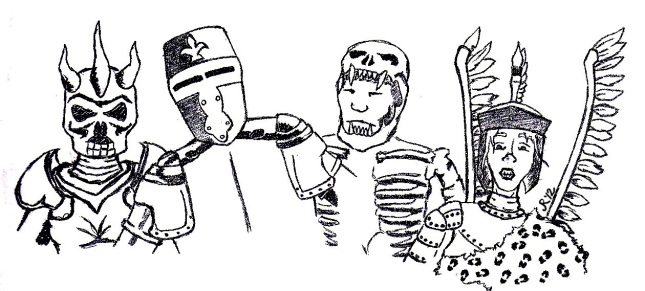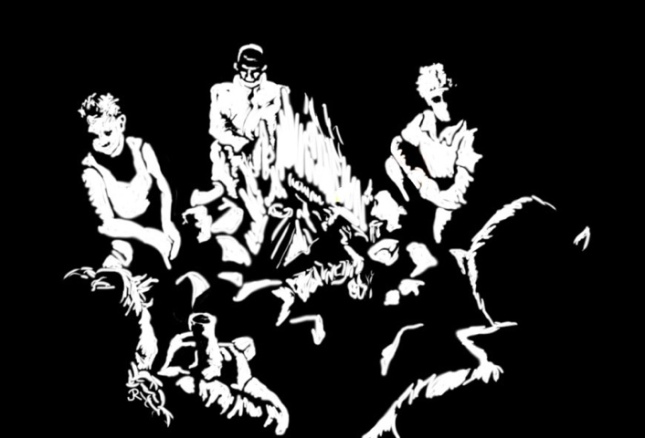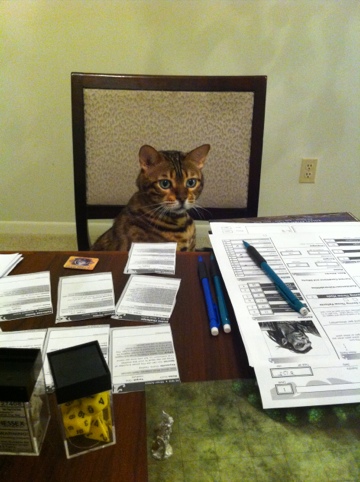
I’m frequently making references to Theater Ninjas, the Cleveland-based theatre company I’m a member of. The brief snatches about my theatre life are usually in context of how I’m dividing myself between many time consuming passions and putting poor Save Vs. Weekend on the back-burner. But in this case, Ninja action applies directly to the gaming world!
The Ninjas actually use games an awful lot in our rehearsal process; both for scripted and self-written original pieces. This year we decided to expand upon the group’s interest in games, and invite the audience in to join us.
Enter our new, free, monthly get-together: GameNight. The focus of GameNight is to introduce fans, collaborators, supporters, new comers, gamers, the curious, their friends, and anyone else to try out some games that focus on story and player creativity. In almost all cases that means some kind of role-playing game. My interest in table-top role-playing grew out of my love of improv and began with traditional titles like my beloved D&D. But recently (and in part because of GameNight) I’ve also branched out into some newer, extremely innovative titles that focus more closely on character and open-ended story-telling. More often than not our selections are (gasp!) totally GMless!
I wanted to share a bit about the games we’ve been playing, and how GameNight can be relevant to D&D players of any edition. There are a lot of facets to what makes a good D&D campaign, and that ultimately comes down to which interests all the players at the table overlap on. But no matter what, story and character are going to play a role: and the more care you put into these elements the more your game will benefit. “Care” in this case does not mean hours of writing or railroading the PCs. It means establishing some simple links between and objectives for characters to inspire players to build the plot and dramatic action themselves. GameNight’s offerings are great at that, and I think each of these indie games has a place in supplementing the regular play (or campaign world prep) of a D&D game.
We started GameNight off with Jason Morningstar’s FIASCO, a game where players create everyday people with burning ambitions and faltering impulse control. FIASCO’s rules build relationships between player characters into the action, – and even folks new to the RPG world take to it easily. A single game of FIASCO can be a good building block for exploring your D&D campaign’s characters, or even figuring out how the party got together before the classic “you are sitting in a tavern when” moment (A suggestion Jason even mentions in the rules for FIASCO). In particular, Wizards of the Coast vet Logan Bonner has written a fantastic FIASCO playset that pairs well with experienced D&D players.
Most recently GameNight took a crack at Ben Robbins’ Microscope. In this game, the players work together to write the epic history of a world by taking turns to create sweeping periods of history, crucial events, and the moment-by-moment role-played scenes that changed the fate of the world. Using Microscope as prep for your D&D game is a good way to bring the players into the world building stage. It can also be a means to sidestep forcing your players to write a 5-page essay explaining their character background (protip: maybe ONE of your players will EVER do this). You can build 1,000 year spans time, or focus in on a few pivotal minutes. Being non-linear, you can hop back and forth down the timeline, zooming in as you wish. Each player has complete, neigh unquestionable authority on their turn, but builds on the ideas of everyone else at the table. It’s your chance to invest the players (and their characters) in the world and its backstory, making them more likely to closely follow the plot and react strongly to the villains, allies, and institutions they run into along the way.
Opening a D&D campaign with one of these (or any of the countless other) “story-games” can reap major rewards in player investment and attention, and does a lot of the dirty work for you. Best of all, it’s actually a lot of fun, and can help burn off any fatigue incurred from playing the same game for a long stretch of time by allowing you to try something new, while still contributing to the host campaign.
I personally advocate for FIASCO and Microscope. Each of the Theater Ninjas’ GameNight events has been a major success. I love to hear the players chatting about that month’s game, the stories they built together, and how they might do things next time as they pack up at the end of a session.
If you’re a gamer in Cleveland Ohio, I highly encourage you to check out the next GameNight event (details at the Theater Ninjas website). I think it’s a foray into a different way to play the kind of games we already love, and gives you ammo and ideas for your own home campaigns. You’ll find some pleasant surprises. But then again, I am a little biased.




